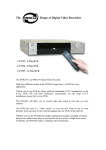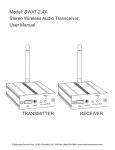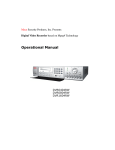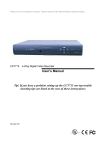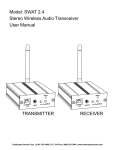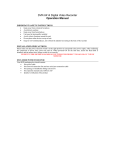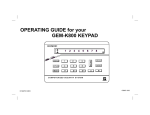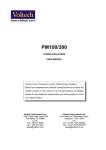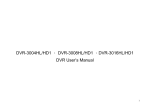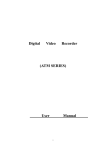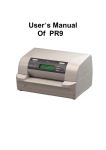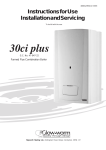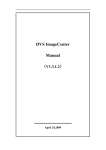Download DVR365 Series II (Silver) - Instruction Manual
Transcript
The Range of Digital Video Recorders The MPEG 4 Digital Video Recorder With three different models in the DVR365 range there’s a DVR for every application. Choose the 4-way DVR for those small but demanding CCTV installations, or the 8way DVR will suit most businesses requirements, for the large CCTV installations choose the 16-way DVR. The DVR365 will allow you to record video and sound in real time on every channel. The DVR also acts as a “video server”so you can now keep an eye on your property from anywhere in the world by logging onto the DVR via the Internet. Whether you use the DVR365 for simple unattended automatic recording of camera pictures in a small corner shop or you monitor the live activity of high street stores worldwide, the DVR365 really is a fantastic all-round product. VERSION 003/OCT2005 1 Operational Precautions ........................................................................ 4 1.1 Accessories Check List .................................................................................. 4 2 Product Features And Specifications .................................................... 5 2.1 Product Features ............................................................................................ 5 2.2 Specification Table ........................................................................................ 6 3 Installation ............................................................................................. 7 3.1 Hard Disc Drive Installation .......................................................................... 7 4 Control Functions .................................................................................. 8 4.1 Front Panel Operation.................................................................................... 8 4.2 Schedule of Key Functions ............................................................................ 9 4.3 Remote Controller ........................................................................................11 4.4 Rear View of the DVR..................................................................................12 4.5 Ethernet LAN port connection ......................................................................13 4.6 RS485 Port (4 / 8 Way DVR) ........................................................................15 5 System operation...................................................................................17 5.1 Start/Stop the recorder ..................................................................................17 5.2 Recording operation .....................................................................................17 5.3 Alarm output ................................................................................................18 5.4 Pan-tilt control operation ..............................................................................18 6 Networking............................................................................................20 6.1 Direct Connection.........................................................................................20 6.2 Local Area Network......................................................................................20 6.3 Internet Connection ......................................................................................20 7 Front panel and remote controller operation ......................................25 7.1 Operation Menu Introduction........................................................................25 7.2 Menu option schedule...................................................................................26 8 Functional Operation............................................................................30 8.1 Recording.......................................................................................................30 8.2 Playback .......................................................................................................30 8.3 Playback fast play.........................................................................................30 8.4 Playback slow play .......................................................................................31 8.5 Control of PTZ equipment ............................................................................31 8.6 Menu operation.............................................................................................32 8.7 Playback of CDROM....................................................................................38 9 Operation via a Network ......................................................................39 9.1 Using the client software ..............................................................................39 9.2 Operation using the Web software.................................................................40 10 A guide to giving your PC an IP number..............................................45 11 Frequently Asked Questions.................................................................48 Appendix A(1) Recording Times at LOW Resolution ..................................50 Appendix A(2) Recording Times at MEDIUM Resolution ..........................51 Appendix A(3) Recording Times at HIGH Resolution.................................52 Appendix B Example on how to setup SCHEDULE recording .......................53 2 1. DVR365 Applications 3 1 Operational Precautions l l l l l l l l l l l l l l l l l 1.1 All the safety and operating instructions should be read before the DVR365 is operated. All the safety and operating instructions should be retained for future reference. Ensure all operating instruction and warning notes are complied with at all times. Do not use strong or abrasive detergents when cleaning the DVR365. There are no user-serviceable parts inside. Please contact a qualified engineer for servicing Do not expose the DVR365 to water or moisture and do not try to operate it in wet areas. Please make sure that both ends of the power lead are plugged in. Do not drop foreign objects through the DVR365’s case or expose it to moisture. Do not attempt to disassemble the DVR365. Contact a qualified engineer if the following situation happens: Ÿ The power lead or plug is damaged. Ÿ The DVR365 has been exposed to rain or water. Ÿ The DVR365 does not operate normally by following the operating instructions. Ÿ The DVR365 falls to the ground or its cover is damaged. When replacement parts are required, make sure that the service engineer has used replacement parts specified by System Q Ltd or that these parts have the same characteristics as the original ones. Unauthorised substitutions may result in fire, electric shock, or other hazards. Use only with a mounting accessory recommended by System Q Ltd. Never push objects of any kind into the case of the DVR365 as they may touch dangerous voltage points or short cut parts that could result in a fire or electric shock. If an outside cable system is connected to the DVR365, be sure that the cable system is grounded so as to provide some protection against voltage surges and built-in static charges. It is recommended that this unit is connected to a power surge protection unit. All normal precautions to avoid component damage due to electrostatic discharge should be taken during installation and operation. To prevent electric shock, do not remove screws or the unit’s cover. Do not cover the radiator fan Accessories Check List 1. One Power Cable 2. One Remote Controller 3. Four HDD Data Cables 4. One Standard Cat 5 Network Patch Lead 5. One Packet Of Installation Fixings 6. One CD For Installation of the Client software and the Player 7. One User Manual 8. Audio Leads (with the 16-Way DVR) 9. One Crossover Lead 4 2 Product Features And Specifications 2.1 Product Features • Real-time Monitor There are two video outputs: 1) Composite video output, for use on a standard CCTV monitor (BNC) 2) VGA output port, for displaying the DVR’s output on a PC monitor Both outputs can display single or multiple channels • Storage The DVR has space internally that allows you to install up to eight large capacity hard disk drives (HDD). If you wish to install an internal CD writer this will take up two drive spaces. The DVR software allows you to decide what to do when the hard disk(s) is full i.e. stop recording or start overwriting the oldest data first. • Back-up There are various ways in which you can back up records that are stored on the DVR to an external device: The unit comes with a Universal Serial Bus (USB) port for connecting external backup devices such as HDD & Caddy, a USB CDROM Writer (CD-RW) and a USB memory stick. Note that some USB memory sticks are not compatible with this unit. The DVR also has the ability to control an internal CR-RW, which means you can fit CD-RW in the DVR itself. You can also connect the DVR to a Local Area Network (using a standard network cable) or directly to another PC (using a network crossover lead), for downloading data to your computer. • Record & Playback Mode The DVR has a built in multiplexer which allows you to view all the cameras simultaneously on the monitor, you can also view individual cameras at the same quality as when in multi screen mode i.e. the images are not digitally enhanced. There are various different recording modes that you can set: Manual recording i.e. you control the recording manually by turning it on/off as and when you want. Timed recording i.e. you can set the DVR to record and stop for given times during the day e.g. 09.00AM to 05.00PM. Event recording i.e. the unit will start to record when it has been triggered, this is a good way to preserve hard disc space. When the DVR is set for alarm / motion recording it will record the previous four seconds to the alarm being activated. The DVR supports triplex operation i.e. you can view live images whilst recording, searching, playing back (on one channel) and transmitting over a network. The DVR offers multiple playback modes: X2, X4, X8 fast play, stop, 15F/S, 5F/S slow play and frame-by-frame playback. • Alarm Input The DVR has eight external alarm inputs that allow devices such as PIR’s, doorbell, door contacts etc to start the DVR recording. The DVR has a built in protection circuit for Alarm input and output. • Pan Tilt & Zoom Control The DVR can control pan-tilt-zoom equipment using its RS485 communication port. It also allows you to control various protocols for different PTZ equipment connected to the unit. • Communication connection port RS232 port supports a standard dial up Modem connection, keyboard for central control, or connection to a computer via serial port for system upgrading. Standard Ethernet port for remote connection and control. Connect the DVR to a router using this port for connection to the Internet (ADSL) 5 2.2 Specification Table Parameter Processor Operation system Model Video input Video output Audio input Audio output Video display Video standard System resource Image resolution Motion detection Video compression Audio compression Image compression rate Video recording speed Image quality Hard disc Alarm input Alarm output Alarm relay MODEM connection Network connection Pan-tilt control Power Power consumption Working temperature Size 4 Channel 8 Channel 16 Channel AMD ELANSC520/133 embedded microprocessor Real-time operation system (RTOS) CCT723 CCT726 CCT727 4 Channel (PAL) BNC 8 Channel (PAL) BNC 16 Channel (PAL) 1.0VPk- Pk 75 1.0VPk- Pk 75 BNC 1.0VPk- Pk 75 1 Channel PAL BNC (1.0VP- P 75 ) video signal 1 channel VGA output port 4 Channel 2008 Channel 20016 Channel 2001000mv10K (BNC) 1000mv10K (BNC) 1000mv10K (RCA) 1 Channel 2000mv 8 Channel 20016 Channel 2001K (RCA) 1000mv10K (RCA) 1000mv10K (RCA) 1&4 window display 1,4,9 window display 1&16 window Display PAL - 625 line, 50f/s Real-time recording, one channel playback and network operation simultaneously (Triplex Operation) Real-time monitor 704×576, playback 352×288, VGA output 720×576 Area setting: 396 detection areas on the screen; 3 different sensitivity levels: Low, Medium & High MPEG-4 CBR (fixed frame rate); MPEG-4 VBR (variable frame rate) Audio: ADPCM 28.8Mbyte/hour; G.729: 3.6Mbyte/hour; Video: 40460Mbyte/hour 352×288CIF format; 176×144QCIF format; 704×576 4CIF format Real-time mode: PAL 1fs-25f/s per channel 6 selectable levels Inside equipped with 4 IDE ports, enabling you to install 8 internal HDDs 8 channel voltage alarm input (+5 - +15V DC. Needed for the alarm input) 3 output channels (output in open/close contact or controllable 12V output) 30VDC 1A, 125VAC 0.5A (relay output) RS232 (Serial Port) RJ45 10Mb Ethernet connection RS485 (4 / 8 Way DVR) A B Connection Terminal (16 Way DVR) 230VAC 60W 70W 80W -10°C - +55°C 441 (Width) x430 (depth) x89mm (height) 6 3 Installation 3.1 Hard Disc Drive Installation The DVR is supplied without HDDs installed, thus one should be fitted before operating the DVR. The maximum HDDs that can be installed internally is eight 400Gb sized drives. Note: .If you install an internal CD-RW or a removable HDD, you will only be able to install five or six internal HDDs. 3.1.1 Installation Steps Note: The CCT723, CCT726 and CCT727 are supplied with silver cases. 1 3 2 1. Remove the outer case of the DVR 2. Remove the HDD bracket from inside the unit 3. Separate the top and bottom part of the bracket 4 4. Install the HDD. Note the HDD is installed upside down, ensuring bracket is in correct 5 6b 6a 5. Screw the two bracket parts together. 6. Set jumper/slave settings on the HDD. The master HDD is connected to the end of the IDE data cable; the slave is connected to the middle connector. 7 7. Fix the HDD bracket into the unit. 8 10 9 4 8. Connect HDD data cable to IDE port ensuring the first connection is used first i.e. IDE1 for first master/slave HDD, the IDE2 for second master/slave etc. 9. Connect power cable to the HDD. Tip. Look for the red cable on the power and the red cable on the data bus; when connected correctly these two cables reside next to each other. 10. Replace the cover. Note. The jumper settings will be given by the HDD manufacturer. Most manufacturers’settings vary. 7 4 4.1 Control Functions Front Panel Operation 5 2 3 4 7 6 9 10 12 8 11 1 15 13 17 18 19 14 20 16 22 23 24 25 26 21 27 28 29 30 16) Function assistant 2 17) Multi-window splitting 18) Function assistant 1 19) Assistant indication light 20) Indicator light for standing by 21) Flying shuttle 22) Multi-window shifting 23) Record 24) Cancel 25) Play last section 26) Slow play 27) Play/pause 28) Fast play 29) Play next section 30) Enter 1) Power switch/indication light 2) Number 3) Recording light 4) Perspex cover 5) CD-RW Bay 6) Address 7) Direction 8) Remote receiver 9) Cancel 10) Enter 11) Direction 12) Direction 13) Direction 14) Information 15) Single window display 8 4.2 Schedule of Key Functions Order Key Name Logo Function Comments 1 Power switch and indication light Power Power Switch Indication Light Power off by pressing the key for 4secs 2 Numbers 1 2 3… . 16 Password input, window shift or number input As number input,10 is equal to 0 3 Recording Light Red on numbers If the light is red, that channel is being recorded 4 Perspex Cover Black Plastic Dust protection 5 CD-RW CD-RW Backup records 6 Address ADD Input remote control address for operation of DVR t u Transverse moving; shifting level 1 and level 2 menu; pan-tilt control pq Lengthways moving; change set-up; change number; pan tilt control 7, 13 Left Right 11, 12 Up down 8 Remote receiver Used to receive the remote signal Cancel 9, 24 Cancel ESC 10 Enter ENTER 14 Information INFO 15 Single window display During playback, restore to real-time monitor Enter Enter main menu Press to show the system information Shift the window to single window In single window mode Press the Function Key to display the pan-tilt control 16 Function assistant 1 Used for setting Motion Detection areas Fn1 During playback, displays the playback status bar 9 During playback use with the number key to start PIP (picture in picture) for playback and realtime monitoring 17 Function assistant 2 18 Multi-window splitting During monitoring switch to a multiwindow display 19 Assistant indicator for standby Indicator light for the function assistant 20 Indicator light for standby Light on when DVR in stand by Flying Shuttle Directional control: outer circle for left and right, inner circle for up and down; When playback, outer circle can control back play and fast play 21 Fn2 22 Multi-window shifting MULT 23 Record REC 25 Play last section 9 26 Slow Play 27 Play / Stop „/; 28 Fast Play 8 29 Play next section : 30 Enter Enter Multi-window shifting during real-time monitoring; during playback, shift between playback and monitor window Start/stop recording, apply together with direction key Play the recording file before the current file 3 levels of slow play speed(15f/S,5f/S,frame by frame) Play/stop When in monitor, press it to enter recording search menu 3 levels of fast play speed,X2,X4,X8 Play the recording file next to the current file Enter Enter main menu 10 4.3 Remote Controller 2 1 3 4 5 6 7 8 10 9 13 11 14 16 15 12 (1) Address (9) Jump forwards (2) Multi-window shifting (10) Play last section (3) Number (11) Jump backwards (4) Record (12) Pause (5) Function assist (13) Play next section (6) Enter / menu (14) Slow motion (7) Cancel (15) Play / Pause (8) Direction (16) Fast Play 11 4.4 Rear View of the DVR 4.4.1 4 / 8 Way DVR On the 4 and 8 way DVR models, the audio and video inputs are all BNC connections. 1 2 3 4 5 6 7 8 9 10 11 Alarm-RS485 connection Audio output (BNC) Audio input (BNC) Power switch 230VAC Mains RS232 connection VGA connection USB port Local Area Network connection RJ45 Composite Video output (BNC) Composite Video input (BNC) 4.4.2 16Way DVR Due to the size restrictions on the rear of the DVR , on the 16 way model, the audio inputs are through a ‘fly lead’as shown on the next page. 14 17 16 15 7 8 9 1011 1 2 3 12 4 5 13 12 6 1. VGA Connection 10. Ground (0V) 2. USB port 11. Ground (0V) 3. IEEE 1394 (Fire wire) port 12. PTZ Control Inputs (A an B) 4. Local Area Connection RJ45 5. Alarm Inputs 13. Composite Video Inputs (1, 3, 5, 7, 9, 11, 13,15) - BNC 6. Alarm Outputs (Normally Open / Closed) 7. Controllable +12V output 8. +12V 9. +12V 14. Composite Video Inputs (2, 4, 6, 8, 10, 12, 14, 16) - BNC 15. Composite Video Output (to monitor) - BNC 16. Audio Output (to loud speaker) - BNC 17. Audio Input Port (Via phono leads) On the 16 way DVR a made up lead is supplied for the audio input port with phone inputs –see below. Note: - ensure that you terminate your audio units into phono plugs. 4.5 Ethernet LAN port connection The DVR can be connected to a local area network (LAN) by utilising the Ethernet connection port provided on the rear of the unit. The connecting cable should be category 5 cable terminated into an RJ45 connector (which is the standard for Ethernet LAN’s). If connected to the network correctly, the indicator light of the RJ45 input port will be on. Note: When connecting directly to a PC via the Network connection, ensure that a crossover lead is used, if connecting through a switcher/hub use a standard LAN lead. 13 The indicator light is on when correctly connected to the network Connect to PC, switch, router or net exchanger Note: Direct connection to PC is possible by bypassing an Ethernet switch, however, one end of the cable is required to be crossed over. See below for connections. 3 1 2 3 4 6 1 4 5 5 6 7 8 2 7 8 Fig 3.4.1 Straight Cable Fig 3.4.2 Crossover Cable CAT 5 Cable Core Number 1 2 3 4 5 6 7 8 Colour Representation WH/OR OR WH/GR B WH/B G WH/BR BR Table 1.0 –Core Number with respect to Core Colour 14 4.6 RS485 Port (4 / 8 Way DVR) Alarm Input Alarm 1 | | | | Alarm 8 Alarm Output ALARMOUT1 Controllable +12V output ALARMOUT2 +12V output Earth Decoder Decoder 120Ω suggested 1, 14, 2, 15, 3, 16, 4, 17 connects to alarm input: ALARM1~ALARM8; 5, 18-OUT1, 6, 19-OUT2 two linked normally open output (alarm outputs) 7, 20-OUT3 are two attached inner lines, either pin is controllable +12V output; 8, 9, 21 are +12V power output, able to be taken as the power supply for an alarm sensor; Pins 10 & 22 are the B line of RS485, 11 & 23 are the A line RS485; Pins 12, 13, 24 and 25 are earth lines +12V GND Com Note: Place a link across the alarm input end and the power NC The connections at the DRV end The connection end of the alarm device +12V | GND Alarm Input The DVR has 8 alarm inputs, either normally open or normally closed type. The power for the alarm sensor can be provided by the DVR (if the DVR powers too many alarm sensors, it may affect the normal working operation of the DVR). 15 Diagram of the alarm input Alarm Output The DVR has two alarm outputs (normally open). In order to avoid overworking the DVR, please refer to the parameters of the relay being used. Diagram of the alarm output The controllable +12V This can be used for the alarm output; you can also use it to restore power to a smoke alarm sensor. RS485 A, B line Used to connect the A and B line for PTZ equipment. 16 5 System operation 5.1 Start/Stop the recorder 5.1.1 Start the recorder. When starting the DVR ensure that the power indicator on the front is illuminated. The system performs a self-diagnostic operation on start up. If the starting time is within the schedule recording time, the system will start recording automatically. Note: - if there is no HDDs installed, the unit will start and you will be able to access menus, there will however, be no recording. 5.1.2 Stop the DVR To turn the DVR off press and hold the power key on the front panel for approximately four seconds; the unit will power down in the correct manner. Then switch off the machine with the power button to the rear of the unit. Note: - Please try to avoid turning the DVR off by removing the mains as this does not allow the unit shut down correctly which could cause the HDDs to develop faults. Also if an internal CD writer is installed and the unit is not powered down from the front of the DVR, the DVR can loose knowledge of the unit and it will be necessary to reset factory defaults. Do not change date or time or previous recordings may be lost. 5.1.3 Power off recovery In the event of a power cut when the DVR is in the state of normal/timing/alarm recording, the recorder will remember what state it is currently in and carry on when the power is returned. Note that the state indicator light is the same as it was before the power was lost. Note: If the power is cut in the state of recording, the system will not store the last 5—15 seconds of recordings. 5.1.4 Password Before you can enter the menu system, you must input a password. There are two levels of password: - user password and administrator password User password 666666 Administrator password 888888 The user password limits you to what functions you can use i.e. it allows you to search video footage, playback and view system information. The Administrator password gives you access to all of the software e.g. you can change system settings etc. 5.2 Recording operation The default recording mode for the DVR is 24hour continuous recording on all channels. The administrator user can choose the suitable recording mode required. Instructions for the different recording modes are as follows: (a) Timing recording Enter the menu, now you can navigate to the Timing and set the timing period for the recording. Note when you go into the timing menu you will see that Sunday is highlighted, to change each day you must go to the required day e.g. Monday, highlight it, you will now notice that both Sunday and Monday are highlighted. To change the times for Monday you must go back to Sunday and un-highlight it. Once you have changed Monday ensure that you save your settings before progressing onto Tuesday. This process must be done for each day See Appendix B for complete details of how to set it up See details at Menu>System setting>Timing 17 (b) Manual recording Press “Record”button on the remote controller or “Record”on the front panel Check the status of each channel in the recording menu; the highlighted channel is the recording channel. For recording on the required channel, simply press the related number key to highlight it. Then press Enter to begin the recording. To stop recording of a particular channel press the related number key. Press Cancel or ESC to return (c) Alarm Recording Alarm recording allows you to increase the recording time of the DVR, as it will only start recording when the PIR etc picks up any movement. Connect the alarm input device to the DVR according to the device connection i.e. Normally Open or Normally Closed detector. Set the correct setting in the menu to start Alarm recording. See details at Menu>System setting>Alarm setting (d) Video Motion Detection (VMD) recording Motion detection recording will also increase the recording time of the DVR, as it will only start the DVR recording when it picks up any movement. Points to consider when using Video Motion Detection: - It is important to remember that the DVR’s VMD circuits look for movement in the camera’s picture, therefore if it is so dark that the camera cannot see any movement nor will the VDM circuits. However, if you were using VMD in a darkened room as soon as the light is turned on, the VDM would cause the DVR to record, as the change in light would be seen as movement. When you are using the VDM with external cameras, sudden changes of bright sunlight to cloud over may cause the VDM circuits to trigger the DVR. With this in mind outdoor use of VDM needs careful planning. In order for VDM to trigger the DVR you need to turn off 24 hour recording on the channel that requires VDM, ensuring that you do this for each day. Now you can turn VMD on. Set up the required times and required motion detection setting in the menu. See details at Menu>System setting>Motion detection 5.3 Alarm output The alarm output can be used to control an external device such as a buzzer to tell the user that that the unit has been alarmed. Or it allows you to remotely control a floodlight e.g. you could turn the light on/off from the other side of the world. The alarm output is directly proportional to the length of the recording time. After an alarm activation the unit will record for a user defined length of time and the output relay will be latched for the same period of time. So if the recording is set at 30secs, the alarm output will be active for 30secs. See details Menu>System setting>Alarm setting 5.4 Pan-tilt control operation The DVR365 range allows you to control Pan Tilt & Zoom Equipment. It is possible to control PTZ equipment from the DVR, using the Remote Controlled Unit provided or you can operate it over a network connection. Confirm the correct connection of the PTZ and the decoder then set the correct decoder address. You should enter the corresponding protocol of the PTZ equipment that you are using, from the Menu>System setting>Control menu NONE PHILIPS HSCP YOUL1 PANA-WV PE5051K DEMO SANTACHI M9500 DH-2 PE5052K EE 18 KALATEL X5600 XCY-RC02 V9KRP INV DRAGON MULTI-AD PANASONIC SHARP SDA WV-CS850 PIH-717 PIH-1016 DSCP2.9 JEC YAAN TCSTD-PP TCSTD-PD TC-615 HHX2000 BOGA TUOXIN JT1641 AD SAE SAMSUNG PELCO-P2 PELCO-P1 PELCO-D1 DH-CC The above table shows the protocols that are compatible with the DVR. Confirm the right connection of decoder’s A, B line and the DVR’s 25-pin port’s A, B line Set the correct setting in the menu. To have control over the PTZ equipment you need to ensure that the monitor is in single window mode (with the camera you require displayed). You should now press the function1 key (Fn1), this gives you the control interface, and if you press it again the next menu will pop up. Use the direction keys to move the PTZ equipment. 19 6 Networking The DVR365 can be networked in three different ways; Direct connection, LAN connection or Internet connection. 6.1 Direct Connection It is possible to connect the DVR directly to a PC that has a Network Interface Card. It must be connected to a P.C using a network crossover lead. You must give the DVR an Internet Protocol (IP) address e.g 192.168.001.108. The subnet mask should be set to 255.255.255.0 Leave the Default Gateway blank. Power down the DVR365 to register the changes. Hold the front power button for 4 seconds, then switch off at the rear. Now power back on at the rear of the DVR and then the front. Now set the PC with a unique I.P address in the same range as the DVR e.g 192.168.001.100 The PC I.P address must not be the same as that entered in the DVR. This can be usually be set on the PC by clicking START > SETTINGS > NETWORK CONNECTIONS > LOCAL AREA CONNECTION> PROPERTIES> INTERNET PROTOCOL (TCPIP) and manually setting the I.P address. The Subnet Mask and Default Gateway must be the same as set in the DVR. Now load the DVR365 client and player software. Further instructions about this are included towards the end of the manual. The client software will require the DVR I.P adddress e.g 192.168.001.108, the subnet mask and Gateway as above. 6.2 Local Area Network You can connect the DVR to a Local Area Network (LAN) using the connection port on the rear of the DVR. You must use a LAN cable. You must give the DVR an Internet Protocol (IP) address. This must be unique to your network but in the same range e.g 192.168.001.xxx. The subnet mask should be set to 255.255.255.0 The Default Gateway should reflect the Router's IP address. Now set the PC with a unique I.P address in the same range as the DVR e.g 192.168.001.100 The PC I.P address must not be the same as that entered in the DVR. This can be usually be set on the PC by clicking START > SETTINGS > NETWORK CONNECTIONS > LOCAL AREA CONNECTION> PROPERTIES> INTERNET PROTOCOL (TCPIP) and manually setting the I.P address. The Subnet Mask and Default Gateway must be the same as set in the DVR. Now load the DVR365 client and player software. The client software will require the DVR I.P adddress e.g 192.168.001.108, the subnet mask and Gateway as above. In order to confirm the correct network connection between DVR and computer, you can use the PING command that comes with Microsoft Windows systems. To access the PING command, follow the sequence below: Start > Programs > Accessories > Command Prompt Once Command Prompt is open type (if 192.168.001.108 is the IP address of the DVR): PING 192.168.1.108 If it comes back and says ‘Request Timed Out’then the two devices are not communicating/connected correctly. This could be due to a bad or incorrect cable connection or the incorrect IP addresses. If it comes back and says ‘Reply from 192.168.001.108’the two devices are connected correctly. 6.3 Internet Connection CHECK LIST –for connecting a DVR365 onto the Internet You need a broadband (ADSL) internet connection at the site where the DVR is to be installed. The ADSL connection at the site where the DVR is installed must have a “STATIC IP address”. This is because the I.P address for Internet use must be unique on the Web. (Note - you can request a static IP address from most Internet Service Providers (ISP’s), but they may charge a small fee for this.) You will need a broadband router/modem at the DVR site. A good one is the Netgear DG834. At the remote site where your computer will be located you will also need a broadband connection to ensure that you have a fast connection to your DVR. TIP - You can’t use a USB type modem connected to a stand alone PC to get the DVR365 connected to the internet, you must get a router-modem, that allows multiple computers to share the broadband ADSL connection. USB modems rely on a computer’s operating system to drive them and the DVR365 cannot do 20 the same thing. Once you have got your ADSL Internet connection with a static IP address at your DVR site, you can progress to installing the DVR. If the site where the DVR is to be installed already has an ADSL Internet connection that is shared by one or more computers it is likely to already have an ADSL modem/router of some description. If this is the case you will have to either configure the existing modem/router or replace it with a new one. If it’s an existing installation, we strongly recommend you enlist the help of the person or company that installed and configured it originally. The rest of these instructions now refer to installation using the Netgear modem/router. 6.3.1 Step 1 Getting the router-modem connected to the Internet If you have already done this and can already “surf the internet”you can skip this section and go straight to step 2. Your ISP should have given you all the information you need to get your modem and computers connected to the Internet. You should have the following information; login user name password static IP address Connect your computer to the Netgear router using the blue STRAIGHT RJ45 cable supplied with the router. Next, you need to set up the router to connect to the Internet. See the Netgear instructions of how to do this if you’re not sure, but the basic method is; 1. Run Internet Explorer 2. Type in the router’s address 192.168.000.1 (usual default for a Netgear) 3. Type in the user name “admin”, 4. Type in the password “password” 5. You should now see the Netgear set-up page. On this page navigate on the left-hand side to the “WIZARD”and run this wizard to set up your connection. When it asks you for the password etc enter them. Obviously the Netgear modem needs to be connected to your ADSL enabled telephone point. When you have finished running the wizard you should be able to test your connection and see live Internet pages on your PC. If you cannot get the Internet connection please run the wizard again and check you have entered your user name and password correctly. If you still have a problem at this stage you MUST CONTACT your ISP. TIP- if you cannot get your computer to connect to the Netgear device, check that your computer is in the same IP address range as the Netgear. This can be found by navigating from My Computer > Control Panel > Network Setting >TCP/IP > Properties. If your computer is set up correctly in the same range as the Netgear router it will look like the following: 21 The Address 192.168.000.XXX means it’s in the same range as other devices that share the same common address 192.168.000. With just the last 3 digits distinguishing between the various devices. For most networks - DO NOT CHANGE the subnet mask and leave it as 255.255.255.000 Once connected to the Internet you now need to set up the router so that you can connect to it and the DVR from anywhere in the world over the Internet. 6.3.2 Step 2 –Setting up your static IP address in the router. In the router navigate to the “Basic Settings”screen and click on “static IP address”. Next enter the STATIC IP address given to you by your ISP, look at the following picture as an example, obviously the IP address in the picture is an example you must enter your own here. The IP address you enter is the STATIC ADDRESS GIVEN TO YOU BY YOUR ISP. Once you have entered this, please click the “apply”button at the bottom of the screen to update the router. Once you have set up your router to work with a static IP address anyone who types this address into their web browser will be re-directed to your router from anywhere in the world. The next task is to make the router “route”this request to the DVR. 22 6.3.3 Step 3 –Make the router “route”external connections to the DVR There are a few ways to do this but we will show you the quickest and most reliable. The Netgear router can be set up to forward all external connections to a particular IP address (equipment) on your local area network, in this case this is the DVR365. The method we are going to show you uses the DMZ feature of the Netgear router. Some other routers have this feature so you will have to “tweak”and apply these notes to your router if it’s a different model. Open the Netgear’s menu marked WAN Click default DMZ server, Now enter the IP address of the DVR365 - by default this may be 192.168.000.111 or possibly 192.168.1.111. Whatever IP address you enter here is the IP address you MUST enter in the DVR. The Netgear router will send all external connections to this IP address. TIP –On a Netgear router the IP address of the DMZ server may appear greyed out, but you will be able to enter and amend the last 3 digits of the IP address. If your local area network is not in the range 192.168.000.xxx, you will need to set up the Netgear router to the appropriate range in its LAN settings screen. Once you have set up the router to use a DMZ server and set up the DMZ’s IP address you can move on to setting up the DVR. 6.3.4 Step 4 –Setting up the DVR The DVR needs to be connected into the same network as the Netgear router or directly to the router itself. To connect into the network or directly to the router, use the “straight”grey RJ45 cable supplied with the DVR. (Note when you are connecting the DVR directly to a computer with no router you need a “crossover cable”. In the DVR you need to set up its IP address to be the same address as you set the DMZ server to be in the Netgear router. In this example, both the DVR’s IP address and the DMZ server’s need to be set up to be 192.168.000.111. Also, you will set up the DVR’s “gateway”to be the Static IP address of the router this means that it accesses the Internet through this “gateway”. In this example the DVR’s gateway will be 82.10.189.10 To get into the DVR menu press “enter” followed by the password “888888” if it’s still the default password Now navigate to System Settings>Network In System Setting enter the details as follows; 23 NETWORK SYSTEM SETTING IP 192.168.000.111 SUBNETMASK 255.255.255.000 GATEWAY 82.10.189.001 SERVERPORT 00080 TCP PORT 37777 MONITOR TCP PLAYBACK TCP SAVE CANCEL Remember: IP address = whatever you set the DMZ server to in the router GATEWAY = the router’s IP address, i.e. your static IP address supplied by your ISP. SUBNETMASK is that of your local area network = Leave at 255.255.255.000 TIP- we recommend you do not change the subnet mask, as this is the default setting for most networks. After you have changed and saved the network settings in the DVR (such as the IP address) you MUST reboot the DVR for these changes to take effect. Obviously please make sure you save the settings before you reboot!! Once rebooted, and if the DVR is connected to the Netgear router you will need to test it from another broadband connection to make sure it is working correctly. Whilst we can help with the DVR settings, it is the ISP's responsibility to advise on the setup of your ADSL connection. 24 7 Front panel and remote controller operation 7.1 Operation Menu Introduction Operation step Enter main menu and level 1 submenu Enter level 2 submenu Set menu contents Exit the current menu Button-pressing order 1,Enter 2,Direction (flying shuttle)pqut Instruction During real-time monitor, press to bring up the password (default six 6’s or six 8’s), now enter the menu. Press to shift among the six options 3, Confirm Enter Enter the selected level 1 submenu 4, Direction (flying shuttle) pqut Press to move and select the level 2 submenu item required 5, Confirm Enter Enter the selected level 2 submenu 1, Direction (flying shuttle) u Select the option to be revised, flashing means being chosen 2, Direction pq Press to revise the settings 3, Confirm Enter Save is flashing, choose to confirm whether you want to keep the revised setting. Direction(flying shuttle) t Return to the last option of the current menu Cancel ESC Exit to the last level menu 25 Screen display Menu SEARCH CONTROL SETTING CH 1 PROTOCOL: PELCO-P BAUDRATE 9600 ADDR 000 SAVE SEARCH CANCEL 7.2 Menu option schedule Main menu Menu level 1 RECORD LIST SEARCH ALARM INFO FILE INFORMATION HDD STATE VERSION Menu level 2 CH 1 DATE 22-08-2005 TIME 02:20 PM PLAY START CH 1 DATE 22-08-2005 TIME 02:20 PM LIST SEARCH DATE 22-08-2005 SEARCH START HDD NUM-0 2 HDD CAP-0 1 6 0 0 8 6M FREE SPACE 0040832M FILE START 2005-04-12 19:00:22 FILE END 2005-08-22-14:20:44 INDEX 12 MASTER W- - - - - - SLAVE - - - - - - CDR STATE NO USB STATE NO VERSION ID 2.45 ISSUE DATE 07-20-2004 WEB VERSION 1.69 26 Remarks Use DIRECTION key to perform setting in menu level 2 See details at 7.3.1 Use DIRECTION key to perform setting in menu level 2. See details at 7.3.1 Not able to search motion detection records. See details at 7.3.1 Displayed information can only be referred to; i.e. it is not modifiable An additional BPS information display shows current BPS rate. Main menu Menu level 2 Menu level 1 GENERAL SYSTEM SETTING SCHEDULE IMAGE ALARM DATE 09 –02 - 2005-09-02 FORMAT MM-DD-YYYY TIME 13: 16: 57 FORMAT 24H 12H SAVE SAVETIME HDDFULL OVERWRITE STOP RECORDLEN 15 MIN REMOTEADDR 008 COMMCTRL NONE SAVE CANCEL CH 1 WEEK S M T W T F S TIME1 00: 00 –24: 00 STATE ON TIME2 00: 00 –24: 00 STATE ON SAVE CANCEL CH 1 MODE CBR/VBR VIDEO/AU FRAMERATE REAL/20FS/15/12/10/8/6-1 BITRATE 1024K/512K/768K/384K/256K/128K QUALITY 4 (1-6) if Variable Bit Rate Selected ALARM: OFF ON1/ON2/ON3 VIDEO: SET DEFAULT TITLE 01 ON SAVE CANCEL CH 1 TYPE NC / NO RECORD 1 2 3 4 5 6 7 8 ALMOUT 1 2 3 DELAY 60 SEC/30SEC/10MIN/5MIN/90SEC TIME1 00: 00 –24:00 ON TIME2 00: 00 –24 00 OFF ALMSVR IP 192.168.000.118 OFF SAVE CANCEL 27 Remarks Main menu Menu level 1 PANTILT CONTROL NETWORK SYSTEM SETTING MOTION DETECTION PASSWORD OTHERS ADMIN SETTING FILE DELETE DEFAULT Menu level 2 CH 1 PROTOCOL NONE BAUDRATE 1200/2400/4800/9600-115200 ADDR 000 SAVE CANCEL IP 192.168.001.108 SUBNETMASK 255.255.255.000 GATEWAY 192.168.000.001 WEB PORT 00080 TCP PORT 37777 MONITOR TCP PLAYBACK TCP SAVE CANCEL CH 1 DELAY 30SEC/10SEC/5MIN/3MIN/60SEC ALMOUT OFF/ON1/ON2/ON3 LEVEL NORMAL/LOW/HIGH AREA SET TIME1 00: 00 –00: 24 OFF TIME2 00: - 00 –24:00OFF SAVE CANCEL GUEST * * * * * * CONFIRM * * * * * * MANAGE * * * * * * CONFIRM * * * * * * SAVE CANCEL PLAYMODE AUDIO SYNC VIDEO BEST ALARM TIP ON/OFF SHUT PASSWORD OFF MONITOR OSD ON/OFF PASSWORD --------- ARE YOU SURE YOU WANT TO LOAD DEFAULT CONFIGURES? YES NO ARE YOU SURE YOU WANT TO GET DEFAULT NETUSER? YES NO Remarks PROTOCOL - a full list can be found in section 6.4 PAN TILT OPERATION The passwords can only be changed by administrator Audio setup SHUT password ON requires a password to close down You must input the Admistrator password if you want to delete data Reloads Factory Defaults. Can reload saved settings from a P.C LOGOUT Press ENTER to logout 28 Main menu Menu level 1 BACKUP RECORDS BACKUP DELETE RECORDS Menu level 2 DEVICE USB/CDR CH 1 BACKUP SPEED NORMAL STARTING DATE 2003-3-18 STARTING TIME 18: 18 ENDING DATE 2003-3-18 ENDING TIME 19:18 BACKUP START DEVICE USB/CDR DELETE CONFIRM 29 Remarks 8 Functional Operation 8.1 Recording Button-pressing order 1, Record REC Instruction Display Press to enter screen display RECORD 1 2 3 4 5 6 7 8 2, Direction pq or the related number key 3, Direction t u 4, Record REC OR Enter Press to shift the recording state on/off. The shadowed means On. Press to shift recording channels. The shadowed means On. Press to save the setting. RECORD 1 2 3 4 5 6 7 8 8.2 Playback Button-pressing order 1, Play/Pause 2, Play/Pause Record information display Instruction Press the button to enter screen display. (If the current state is logged out, please enter password) Press twice to begin the playback (on the screen shows channel, date, time). If it shows no record found, the operation will not take effect. After the completion of the playback, it shows “The End”. Display Record Search CH 1 DATE 03-03-2003 TIME 09 PLAY START 10 AM Record Search CH DATE 1 03-03-2003 TIME 09 PLAY NO RECORD 10 during playback, press Fn to display or hide the playback state bar. 8.3 Playback fast play Button-pressing order 1,Fast play 8 2,Play/Pause 3,Play next section, play last section Instruction During playback press this key to shift between 2 times speed, 4 times speed, 8 times speed. During fast play press this key to shift between play and pause. During playback state it takes effect. Press9 :to view the next or last record of the same channel. 30 Display CH1 PLAY X2 8.4 Playback slow play Button-pressing order 1, Slow play Instruction During playback press to shift among 25f/s, 15f/s, 1f/s speed. 2, Play/Pause During slow play of the playback record press to shift between play and pause. 3, Play next section, play During playback state it takes effect. Press9 last section :to view the next or last record of the same channel. • 1f/s speed slow play is frame by frame. Display CH1: PLAY 15F/S 8.5 Control of PTZ equipment For control of the PTZ camera, ensure that you have the required camera in the single screen mode Button-pressing order 1, Refer to menu operation Instruction In Control Setting select the related Channel and Protocol, see the right picture. Set the conformed Baud rate and Address with the decoder. Press Enter to save. 2, Assistant function Fn1 Under the state of single window monitor, press Fn1 to enter the screen display. Press again to shift amongst: PT Control DIRECTION LENS Control ZOOM FOCUS IRIS Light Control (OFF ON). 3, Direction pqt u Control the related pan-tilt, lens and light. Press Fn to display Control Setting CH 1 PROTOCOL DH-CC440 BAUDRATE 9600 ADDR 000 SAVE CANCEL PT CONTROL p tDIRECTIONu q LIGHT CONTROL t OFF ONu 31 8.6 Menu operation *Please refer to ‘Menu option schedule’; button operation refers to the above form* *All the below settings of the menu must be saved before taking effect. * 8.6.1 Record Search Record Search Record START First set the channel, date and time you want to search, then select List First set the channel, date and time you want to search, and then select SEARCH, the screen shows the 8 recording files following the searching time. Use pq to select the file to be played. Press ENTER to begin the playback. Note: the letters before the record are equal to following: R - Record: M Motion detection: A - Alarm Alarm First set the searching date, then select START, all the alarm records will be displayed. Press pq to select the record. Press ENTER to play the alarm record. Note motion detection alarm cannot be searched in this category, but can be searched in RECORD and LIST. 8.6.2 Record Search CH 1 DATE 2003-12-08 TIME 08:18AM PLAY START List Search CH 1 DATE 2003-12-08 TIME 10 10AM LIST SEARCH ALARM SEARCH DATE 2003-12-08 SEARCH START Information SYSTEM INFORMATION HDD NUM 01 HDD CAP 0080043M FILE START 2003-12-08 00:08:08 FILE END 2003-01-08 18:18:18 SYSTEM PRESS ENTER INTO BITRATE INFORMATION BPS System Info Displays HDD number, HDD capacity, remaining space, recording start time (the earliest recording time among all the HDDs) and recording end time. All this information is non editable. Press Enter to enter the bit rate information sub-menu Display the frame rate of the current channels. Frame rate (Kb/s) HDD space occupied (Mb/h) HDD Display HDD index and the conditions of master drive and slave drive. Note: If the HDD is in operation, it will show as “W”. Version The issuing date and ID of the operation system. This information is not modifiable. 32 CH.1 CH.2 CH.3 CH.4 0538Kb 0302 Kb 0267 Kb 0112 Kb 256M/H 132M/H 117 M/H 49M/H CH.5 CH.6 CH.7 CH.8 0663 Kb 0227 Kb 0050 Kb 0283 Kb 291M/H 99M/H 21M/H 124M/H PRESS ESC TO QUIT HDD STATE INDEX 12345678 MASTER -W----SLAVE ------CDR STATE NO USB STATE NO 8.6.3 System Settings Menu SYSTEM SETTING General This sub menu allows you to change the DATE & GENERAL SETTING TIME and format that it is displayed in e.g. DD-MMDATE 12-23-2003 YYYY or MM-DD-YYYY etc. When you have FORMAT MM-DD-YYYY TIME 02:20:22 PM changed the time & date please ensure that you press FORMAT AM/PM the SAVETIME function, otherwise the time will not SAVE SAVETIME HDDFULL OVERWRITE be changed. RECORDLEN 60 MIN REMOTEADDR 008 HDDFULL SAVE CANCEL This allows you to choose what to do when the HDD is full i.e. you can stop the DVR from recording or you can make it start recording again. The DVR’s software will look at the earliest recorded date on the HDD and it will start recording from that point. RECORDLEN To make it easier to search for video footage the DVR stores records in blocks. You can choose what length these blocks are i.e. on the 4 / 8 Way DVR the blocks are 15Min, 30Mins and 60Mins. On the 16 Way DVR the blocks are REMOTEADDR This allows you to set the address of the remote control; its default address is 008 COMMCONTROL When you have changed the details in this sub menu please press the save function. Note: System date/time cannot be changed freely. If changed after recordings have been made, file directories are altered and data may be corrupted or lost. Timing This is a very powerful menu; it is where you set up your required recording schedules. It allows you to set different recording times for different cameras on different days of the week e.g. you could set Channel 1 to be recording for 24hours a day, 7 days a week whilst cameras 2, 3, and say 6 are recording between the hours of 0900 –1700. Channels 4, 5 & 8 may be set up as event only recording. You may not be using all your channels, so therefore to save recording time on your HDD you can stop the DVR from recording on these channels. TIMING RECORDING CH WEEK TIME 1 08:00 PM STATE TIME 2 08:00 PM STATE 1 S M T W T F S 08:00 AM – OFF 08:00 AM – OFF To set up your DVR to record all channels 24/7 please follow the operation given: Select your required channel. In WEEK you will notice that S (for Sunday) is highlighted and no other day is highlighted. This has to be the case for each day you set up i.e. you can only set up one day at a time. You can now set up the schedule for this day e.g. TIME 1 00:00-24:00, ensure that STATE 1 is ON. STATE 2 should be OFF To stop the DVR recording channels, set STATE1 and STATE2 to OFF. Note there must be at least one day highlighted at all times, therefore you have to highlight the day you require, then go back and un-highlight the day that is no longer required. If you have more than one day highlighted the DVR will not run as expected. 33 ImageMode This sub menu allows you to change the rate at which the DVR records IMAGE SETTING CH 1 video footage. MODE CBR VIDEO VBR VIDEO/AU FRAMERATE REAL 20FPS – 1FPS The CBR (Constant Baud Rate) setting will only allow to record in real BITRATE 1024K-128K time (25f/s), but you can however, change the bit rate (Resolution) from: QUALITY 4 ALARM OFF 0N1-ON3 128k, 256k, 384k, 512k, 768k, 1024k. VIDEO SET DEFAULT The VBR (Variable Baud Rate) setting will allow you to change the TITLE 01 ON recording rate from real time, 20f/s – 1f/s i.e. it will record at a lower SAVE CANCEL frame per second which will save HDD space. You can change the video quality from 1 –6, where 6 is the highest quality. The main difference between CBR & VBR is that CBR records all of the image all of the time, VBR only records the image when there is movement i.e. VBR saves on HDD space and is the better setting for transmission over a network. Alarm If you turn the Alarm on in this menu, the DVR will sound and trigger the alarm output when there is video loss. Video This is a preset default that sets up the HUE, Contrast, Brightness and Saturation of the channels. Title This setting allows you to give names to the channels. Alarm Settings This sub menu allows you to set up your external alarm inputs such as PIRs, door contacts, doorbells etc. You can set each alarm input individually by setting the required channel in CH. The TYPE allows you to select Normally Open (NO) or Normally Closed (NC) depending on your input type. After the external input you would want your DVR to start recording, The RECORD allows you to select which channels to record i.e. you may want to record the channel that was activated or you may want to record every channel after an alarm activation. DELAY is the time that the DVR will record for after an alarm input, 10,20,30 90seconds Select the relevant channel in CH. TYPE has NO (normal Open) or NC (normal closed) electrical outputs. If the number in RECORD were selected, recording would be started automatically when there is an alarm input. If the alarm output port is chosen, it will trigger corresponding equipment when there is alarm input. DELAY means to lengthen the recording time after receiving alarm signals (10, 20, 30,… … 90SEC). When the outside alarm is cancelled, the system will lengthen the recording time automatically before closing the alarm and relay output. When Time 1 & Time 2 are open, within the time of the setting the recording will be triggered by alarm signals. The beginning time should be earlier than the ending time; the setting in Time 2 should be later than the setting in Time 1. ALMSVR IP is used 34 ALARM SETTING CH 1 TYPE NO NC RECORD 1 2 3 45678 ALMOUT 1 2 3 DELAY 60SEC/30SEC/10MIN/5MIN/ 90SEC TIME 1 00:00 – 24:00 STATE ON TIME 2 00:00 – 24:00 STATE OFF ALMSVR IP 192.168.000.117 OFF SAVE CANCEL to transmit the alarm signals to the designated IP server. This is only available on certain models. Pan –Tilt Control Select the channel for the PTZ camera and choose the protocol for the corresponding PTZ decoder. Set the ADDR which is the unique address of the corresponding decoder. See Section 6.4 PAN TILT OPERATION for a full list of the protocols and recommended baud rates available. Tip… When using PTZ cameras allocate PTZs starting at channel 1. Network The IP address is set by using pq or input the exact numbers to change the IP address. The related SUBNETMASK and GATEWAY should be set according to the IP address. MONITOR and PLAYBACK can be changed by using pq (TCP/IP, MULTICAST). Reserve the setting in SAVE and RESTART the recorder. CONTROL CH PROTOCOL BAUDRATE ADDR SAVE 1 NONE 1200 000 CANCEL NETWORK SETTING IP SUBNETMASK GATEWAY WEB PORT TCP PORT MONITOR PLAYBACK SAVE 192-168-000-141 255-255-255-000 192-168-000-001 0008 37777 TCP TCP CANCEL Note: MULTICAST: The users with manage can monitor each channel freely, and other users can only view after them. 5 users at maximum. TCP Protocol: All users are able to monitor any channel. User shall select according to necessity. If you want to transmit over the Internet then TCP should be chosen. 2 users at maximum. Motion Detection The DVR365 range comes with built in video motion detection circuits on each camera input – this can save you having to install external alarm input devices. For the video motion to be operational please turn off recording in the TIMING menu for the hours you wish VMD recording to be active. DELAY This allows you to set how long the DVR will record for after alarm activation i.e. 5Mins, 3Mins, 60secs, 30secs or 10secs. Note the DVR will record the first 4seconds before it was sent into alarm. ALMOUT With this set to ON, when the alarm is activated the DVR will operate the output relay, the relay stays on for the duration 35 MOTION DETECTION SETUP CH 1 DELAY 30SEC ALMOUT OFF/ON1/ON2/ON3 LEVEL NORMAL/LOW/HIGH AREA SET TIME 1 08:00 AM – 08:00 PM TIME 2 08:00 AM – 08:00 PM SAVE CANCEL of the alarm i.e. if you set it to record for 60secs the relay will be on for 60secs. LEVEL You can set how sensitive you want the VMD to be i.e. HIGH, NORMAL or LOW AREA It is possible to set areas of the camera image up for VMD i.e. you may only want the DVR to start recording when a vehicle drives through a gateway. This is set up by going into the SET sub menu. The blue squares represent active VMD areas; clear squares are when there is no VMD active. You will see a pink square that you can move across the screen using the cursor keys; to toggle the squares press the Fn key (the cursor square will now be white). As you now move it around it toggles the blue area to clear, thus turning off VDM and vice a versa. TIME 1 TIME 2 Set these for the hours you want VMD to be active. 8.6.4 Admin setting ADMIN SETTING 36 Password To change the GUEST or ADMINISTRATORS password simply move across to the required one and enter your new password using the number keys and confirm by entering your new password again. Note only the Administrator can change the password. Others With ALARM TIP on, when there is an alarm input from an external device, the DVR will display the alarm information on screen. If SHUT PASSWORD is on, you need to input the right manage level password before turning off the DVR; if it is off, you need to press and hold the power button for 4 seconds for the DVR to power down. OUTPUT X POINT and OUTPUT Y POINT are set for the starting point of the window on the screen, and PLAYBACK HEIGHT is to set the window height during playback. Audio Mode can be set to either PCM (Pulse Code Modulation) or ADPCM (Adaptive Pulse Code Modulation) Multiplay can be set to ON or OFF File/data Delete This is used to clear the data on the HDD. Be careful with this item. Before you delete the data, you have to input the administrator’s password. Default This allows you to reset all the settings to the factory default. Note only use as a last resort. Logout Press to logout from menu operation. 8.6.5 Backup Records BACKUP RECORDS Backup records 37 OTHERS ALARM TIP ON/OFF SHUT PASSWORD OFF/ON OUTPUT X/Y POINT 000/000 PLAYBACK HEIGHT 480 AUDIO MODE PCM/ADPCM TITLE COLOUR <LIST> Multiplay ON MAINTENANCE WEEK DATA DEL PASSWORD: _______ DEFAULT LOAD DEFAULT ONFIGURES? YES NO RESET NETWORK USER TO DEFAULT? YES NO There are various ways in which you can back up records that are stored on the DVR to an external device: The unit comes with a Universal Serial Bus (USB) port for connecting external backup devices such as HDD & Caddy, a USB CDROM Writer (CD-RW) and a USB memory stick. Note that some USB memory sticks are not compatible with this unit. The DVR also has the ability to control an internal CR-RW, which means you can fit a CD-RW in the DVR itself. This usually takes up the space of two/three HDD drives. Move the cursor to select the backup device, channel number, starting date and time, ending date and time, and then select to start the backup, and system will display the backup processing. If the user does not connect the backup device right, system will give a warning: No backup disk; if the device is full, it will display: Disk is full: During the backup, it will display the time left. For the backup device you can choose between USB and CDR. BACKUP RECORDS BACKUP DEVICE CDR/USB CH 1 BACKUP SPEED NORMAL STARTING DATE 2003-3-18 STARTING TIME 9 18AM ENDING DATE 2003-3-18 ENDING TIME 10 BACKUP 18AM ADD START CD Writer Not Detected When a CDR is installed in the DVR365, it is possible that the CDR may not be detected. This can occur when the DVR looses power and is not taken down correctly. It is important that when powering down the DVR that the front power button is held in for 4 seconds and then the rear power switch, switched to off. To remedy this situation, first power up the machine by the mains switch at the back, then hold the power button on the front of the DVR for a few seconds. Now enter the System menu, go to Admin and select Default. Reply yes to Load Default Configuration. Then power off the unit with the power button on the front of the machine and after a few seconds re-power using the front button. The CD writer should now be detected. This can be confirmed by entering the Information Menu, Hard Disk State and checking to confirm that the CDR STATE shows YES. IMPORTANT REMINDER Do not be tempted to change either the date or time after resetting defaults as the DVR uses the current date and time to reference the directories of files created. Changing the Date and or Time may corrupt the recorded data and you will have to reformat the hard drive/s and thus loose all previously recorded data. Delete backup Select the backup device you want to delete the records from first, and then confirm the deletion by selecting Yes 38 8.7 Playback of CDROM When the backup CD has been created, you may wish to view the recording. You will need to have either the Client software or the Player software loaded on your P.C as the recorded data is encrypted and can only be viewed via this software. Using the Client software, double click on the DVR365 icon. Now click here –last button You should now see a playback module. The right hand buttons can be used to view the recordings or you can record part of a video sequence direct to your HDD by pressing the first left hand button Save Record, followed by the second Stop Save button. This is saved to C:\download. To capture a still frame, press Pause followed by Capture. Save record Stop save Capture picture 39 Full screen 9 Operation via a Network There are two ways in which you can access the DVR over a network; one way is to use the client software that is provided on the CD, the other way is to use an Internet Browser such as Netscape or Internet Explorer. 9.1 Using the client software Once you have installed the software on your PC, there should be an icon on your desktop that points to the software. Once you have opened the software you will see the following interface on your monitor: Now click on the Login icon The following menu is now opened. Click on the Network Login then click OK This menu allows you to add the IP number of the DVR you are accessing Click on the Add button. 40 Enter a Name for your DVR, then enter the IP number and press OK (the Port number is defaulted to 37777) You can now click on the Login button; you will be prompted for the username and password: The default Username is admin The default Password is admin You should now be logged into the DVR. The first task you should complete is to change the default administrator User & Password and add a general user. This is done through the Assistant>User Manage The software allows you to have full control over the DVR. 9.2 Operation using the Web software You can log on to the DVR from anywhere in the world by accessing it over the Internet. The DVR sends software to the Internet browser that is trying to access it. All you have to do is type the IP address in the address bar of an Internet browser; the DVR will then send the program to the browser. You can now logon to the system and have the same control over it as you would when using the Client software. Note this software does not need to be manually installed. Please check the connection of the network, for example, ping the IP address of the DVR. 9.2.1 Login and logout Please input the IP address of the DVR in the address bar of an Internet browser. Take the DVR’s IP address: 192.168.001.108 as an example: Input http://192.168.001.108. At the first time of visiting this DVR the system will pop up the dialogue box to ask whether you accept ActiveX or not, and please choose Yes, then the system will install the software automatically. 41 You will now see an interface where you can choose to Login: Enter the user name and password for your DVR and click OK. You can now view the cameras in live mode by clicking on the relevant number at the top of the screen. 42 Note: depending which model you have will determine how many cameras are displayed i.e. 4way gives you 4, 8-way gives you 8 and the 16-way gives you 16 cameras that you can view. 9.2.2 Records Search Click on search icon, the following box will open and allow you to enter time parameters for searching the DVR. Save record Stop save Capture picture Full screen During playback of video, you can record part of the video to your local HDD by pressing the Save record button, followed by the Stop button when you have enough of the video saved. Note this video is saved to C:\download 43 9.2.3 Configure the System setting The Config menu gives you five sub-menus; General, Timing, Image, Alarm, and Motion Detection Note: The menus that are ghosted mean that you can only change them on the DVR. The General sub-menu includes the recording length setting. In the Control Column you set up the DVR to control PTZ equipment. The Timing menu allows you set up schedule recording for each channel. There are two time periods you can set, Time 1 and Time 2. This allows you to set two different times (during one 24h period) that the DVR is to record. Note when setting the dates please do this on a day-by-day basis i.e. not a week at a time. Motion detection can be set from this menu, ensure that you turn OFF recording in the schedule first, or the Motion Detection time is after the End times in the schedule. Image: In this menu you can select the image quality and protocols for each channel. 44 There are two types of Network transmission Protocols available: TCP and Multicast. Multicast protocol: the user with admin control power can view the images at will, other users can only view what the admin user is viewing. 5 users are allowed to view at the same time. TCP protocol: each user can view the image at will. According to the need, user can choose the different protocol. If it is through the Internet you must choose TCP. 2 users are allowed to view at the same time. Alarm: When there are alarm input signals, you can select the recording channel and the output port Motion Detection: This menu allows you to select which area of the cameras you wish motion detection to be active on. The coloured area is the selectable motion detection area. The user can highlight areas to select the detection area and set the sensitivity of the area due to the requirement. 45 10 A guide to giving your PC an IP number. In order for you to control the DVR from a PC you need to give your PC an address that is similar to the IP number of the DVR. 1. Ensure that you have a Ethernet Network card installed in your PC 2. In order to give it a number you need to point to: Start>Settings>Control Panel In Control Panel you should look for Network and Dial-up connections, Double click on the icon. In this folder you should see an icon that says Local Area Connection. Highlight it and Right Click on it: 46 Click on Properties The following screen should pop-up Highlight the Internet Protocol (TCP/IP) and then click properties. The next box that you see shall be the one where you put all the IP numbers. Click on the ‘Use the following IP address’ Now enter your IP address and Subnet mask. 47 Press OK and then restart your PC. NOTE: If you are installing the DVR on a Local Area Network and want to connect it to a PC on the same network, you must give them both the same subnet mask. It is this mask that distinguishes that they are on the same network. This is usually 255.255.255.000 48 11 Frequently Asked Questions a) How to set up the remote controller. Via the DVR menu system, go into system setting then general; now make a note of the remote address number e.g. 008. Point the remote controller at the DVR and press the ADD button, a small window will appear on the screen: ADD ---, now enter the three digit code that was noted, the remote control should now be operational. b) How do I cascade more than one DVR? Where an application of seventeen or more cameras is required, two DVR’s can be used to view the cameras. It is possible to set up more than one DVR on a network. By dedicating each DVR on the network an individual IP address makes it possible to view the DVR’s via the network software. c) What to do first. With the power switched off, confirm that the inner wiring connections are correct and at least one HDD is connected (the capacity of it should be over 3GB). Then connect the power cable. The DVR then checks the last function status. If it was shut down normally, the DVR will go into the stand-by state. (The ACT light is on, POWER is off, and the system only responds to the POWER key), otherwise, the system restores to the previous function state and continues. d) What the bleeper sound means when normally starting the machine? When the machine is started successfully, it emits a short bleep. When the HDD cannot be identified, a long bleep is emitted. When communication with the controller panel is abnormal, the DVR emits one long bleep followed by two short bleeps. e) What recording methods are available Timed recording, video motion detection recording, manual recording and external event trigger recording. Confirm each setting is correct and that they do not conflict with each other. Note that video motion detection recording and timed recording must not be set to cover the same time. f) The indicator light is flashing while recording: Check the external video input signal. The light flashes when the video input signal is a nonstandard type. This problem can also be caused by the HDD speed being to slow. If this is the case, the HDD should be changed. g) What kind of external equipment can be used with the DVR? It can operate with various matrix and decoder cards for PTZ operation. It will interface with many USB data storage devices including USB memory sticks, CD writers (both internal and external) and other USB data storage devices. USB 1.1 memory sticks have been tested successfully. Not all memory sticks are compatible. It will interface directly through a P.C, or via a LAN or via a high speed Broadband link. h) Why is there no ventilation fan? The DVR’s IC’s all have low power consumption thus they generate little heat. The DVR has intelligent software programming i.e. if there is no operation for 10mins, the un-working disks go into standby mode. i) How do I know if the DVR has had an alarm activation? It is possible to set the DVR to display an on screen message to notify the user of an alarm. To set this up you must: go into the menu, then into admin settings and others, now set “ALARM TIP”to on. You can also set the network software to display the alarm by: In the software go into Assistant, then into Systems Settings, tick the Alarm Prompt yes button. 49 j) Can I set up a multiple screen over the network? When logged into the DVR using the Internet browser it is possible to view 1 - 4 channels over the network simultaneously. Log in and right click in the blue screen. The menu gives you the ability to view one or two channels, by adding a new channel you can add two more channels. It is also possible to view all four channels in large screen by using right hand click menu and selecting full screen arrangement in video windows. k) What is the procedure I must follow to set up the record timer? In order to set up the DVR to record certain cameras at certain times please follow the following instructions: 1. Enter the menu system as normal. 2. System Settings 3. Timing This menu allows you to set which channels the DVR is to record at desired times e.g. you may wish the recorder only to record when the office is closed, or you may want to record when staff are about. This menu gives you two recording times i.e. you may want to record between the hours of 0900 –1200 and 1300 –1700; the recorder would not record between 1200 and 1300. In order to set the recording times to your individual requirements please follow the instructions below carefully. Set which channel that you require to control. Now scroll down to WEEK S M T W T F S. The letters represent the day of the week. Sunday will be highlighted every time you enter this menu as default. To change this you must scroll along to the desired day, highlight it (the corresponding letter will change from white to red), then go back to Sunday and deselect it. You can now set up the desired time for that day by scrolling down to the times below. You must treat the recording times on a day by day every day basis i.e. you cannot highlight Sunday through Saturday and set the recording times, likewise you cannot set for example, Monday and Wednesday simultaneously. Although the DVR will let you select more than one day at a time it will not perform the desired operation. If you do not use all the channels provided by the DVR, then you should turn the channels off in this menu for each day of the week. Always save the settings before exiting so they are stored by the DVR. Note If you do not turn the channels off in this menu but manually stop the DVR from recording, after the user changes a setting, the DVR will start recording all the channels again automatically, as the setting was not saved to memory. The timing menu stores the instructions, so that even when the DVR has been subjected to power loss it remembers its settings. l) The Menu instructions in this manual differ from that displayed by the DVR. Whilst every effort is taken to ensure the accuracy of this manual, it has been designed to cover operation of the DVR365 range of DVRs and there will be some differences in the various models. Also the manufacturer provides software upgrades on a periodic basis with new functionality. We therefore cannot accept responsibility for errors, omissions or changes made to hardware or software specifications nor can we accept responsibility for any operational issues, loss of data, or incorrect operations caused by interpretation of these procedures. 50 Appendix A(1) Recording Times at LOW Resolution The recording length is determined by the capacity of the installed HDDs, the number of cameras recording and the resolution setting selected. (Resolution settings 1 –6 where 1 is lowest resolution) dy = days hr = hours LOW RESOLUTION GB/Hr mth = month/s 80Gb 160Gb yr = years 200Gb 250Gb 300Gb 400Gb SETTING 1 6x 8x 400Gb 400Gb 2.4Tb 3.2Tb (without audio) 1 camera 0.06 55 dy 111 dy 138 dy 173 dy 208 dy 277 dy 4.5 yr 6 yr 2 cameras 0.12 27 dy 55 dy 69 dy 86 dy 104 dy 138 dy 2.2 yr 3 yr 3 cameras 0.17 19 dy 39 dy 49 dy 61 dy 73 dy 98 dy 1.6 yr 2.1 yr 4 cameras 0.23 14 dy 29 dy 36 dy 45 dy 54 dy 72 dy 1.1 yr 1.5 yr 5 cameras 0.29 11 dy 23 dy 28 dy 35 dy 43 dy 57 dy 11 mth 1.2 yr 6 cameras 0.35 9 dy 19 dy 23 dy 29 dy 35 dy 47 dy 9 mth 1 yr 7 cameras 0.41 8 dy 16 dy 20 dy 25 dy 30 dy 40 dy 7.8mth 10 mth 8 cameras 0.46 7 dy 14 dy 18 dy 22 dy 27 dy 36 dy 7 mth 9.3mth 9 cameras 0.54 6 dy 12 dy 15 dy 19 dy 23 dy 30 dy 5.9mth 7.9mth 10 cameras 0.60 5 dy 11 dy 13 dy 17 dy 20 dy 27 dy 5.3mth 7.1mth 11 cameras 0.66 5 dy 10 dy 12 dy 15 dy 18 dy 25 dy 4.8mth 6.5mth 12 cameras 0.72 4 dy 9 dy 11 dy 14 dy 17 dy 23 dy 4.4mth 5.9mth 13 cameras 0.78 4 dy 8 dy 10 dy 13 dy 16 dy 21 dy 4.1mth 5.5mth 14 cameras 0.84 3 dy 7 dy 9 dy 12 dy 14 dy 19 dy 3.8mth 5.1mth 15 cameras 0.90 3 dy 7 dy 9 dy 11 dy 13 dy 18 dy 3.5mth 4.7mth 16 cameras 0.96 3 dy 6 dy 8 dy 10 dy 13 dy 17 dy 3.3mth 4.4mth NOTE: Deduct 15% time for each channel set with audio functionality The above table shows some average storage times that use constant baud rate (CBR) coding techniques. If you used the variable baud rate (VBR) coding technique that is available, and your cameras are set for motion detection operation, this will save more HDD space. 51 Appendix A(2) Recording Times at MEDIUM Resolution The recording length is determined by the capacity of the installed HDDs, the number of cameras recording and the resolution setting selected. (Resolution settings 1 –6 where 1 is lowest resolution) dy = days hr = hours MEDIUM RESOLUTION GB/Hr mth = month/s 80Gb 160Gb yr = years 200Gb 250Gb 300Gb 400Gb SETTING 4 6x 8x 400Gb 400Gb 2.4Tb 3.2Tb (without audio) 1 camera 0.23 14 dy 29 dy 36 dy 45 dy 54 dy 72 dy 1.1 yr 1.5 yr 2 cameras 0.46 7 dy 14 dy 18 dy 22 dy 27 dy 36 dy 7mth 9.3mth 3 cameras 0.69 4 dy 9 dy 12 dy 15 dy 18 dy 24 dy 4.6mth 6.2mth 4 cameras 0.92 3 dy 7 dy 9 dy 11 dy 13 dy 18 dy 3.5mth 4.6mth 5 cameras 1.15 2 dy 5 dy 7 dy 9 dy 10 dy 14 dy 2.8mth 3.7mth 6 cameras 1.38 2 dy 4 dy 6 dy 7 dy 9 dy 12 dy 2.3mth 3.1mth 7 cameras 1.61 2 dy 4 dy 5 dy 6 dy 7 dy 10 dy 2mth 2.6mth 8 cameras 1.84 1 dy 3 dy 4 dy 5 dy 6 dy 9 dy 1.7mth 2.3mth 9 cameras 2.07 1 dy 3 dy 4 dy 5 dy 6 dy 8 dy 1.5mth 2mth 10 cameras 2.30 1 dy 2 dy 3 dy 4 dy 5 dy 7 dy 1.4mth 1.8mth 11 cameras 2.53 1 dy 2 dy 3 dy 4 dy 4 dy 6 dy 1.2mth 1.7mth 12 cameras 2.76 1 dy 2 dy 3 dy 3 dy 4 dy 6 dy 1.1mth 1.5mth 13 cameras 2.99 1 dy 2 dy 2 dy 3 dy 4 dy 5 dy 1mth 1.4mth 14 cameras 3.22 1 dy 2 dy 2 dy 3 dy 3 dy 5 dy 1mth 1.3mth 15 cameras 3.45 23hr 1 dy 2 dy 3 dy 3 dy 4 dy 28 dy 1.2mth 16 cameras 3.68 22hr 1 dy 2 dy 2 dy 3 dy 4 dy 27 dy 1.1mth NOTE: Deduct 15% time for each channel set with audio functionality The above table shows some average storage times that use constant baud rate (CBR) coding techniques. If you used the variable baud rate (VBR) coding technique that is available, and your cameras are set for motion detection operation, this will save more HDD space. 52 Appendix A(3) Recording Times at HIGH Resolution The recording length is determined by the capacity of the installed HDDs, the number of cameras recording and the resolution setting selected. (Resolution settings 1 –6 where 1 is lowest resolution) dy = days hr = hours HIGH RESOLUTION GB/Hr mth = month/s 80Gb 160Gb yr = years 200Gb 250Gb 300Gb 400Gb SETTING 6 6x 8x 400Gb 400Gb 2.4Tb 3.2Tb (without audio) 1 camera 0.46 7 dy 14 dy 18 dy 22 dy 27 dy 36 dy 7mth 9mth 2 cameras 0.92 3 dy 7 dy 9 dy 11 dy 13 dy 18 dy 3.5mth 4.6mth 3 cameras 1.38 2 dy 4 dy 6 dy 7 dy 9 dy 12 dy 2.3mth 3.1mth 4 cameras 1.84 1 dy 3 dy 4 dy 5 dy 6 dy 9 dy 1.7mth 2.3mth 5 cameras 2.31 1 dy 2 dy 3 dy 4 dy 5 dy 7 dy 1.3mth 1.8mth 6 cameras 2.77 1 dy 2 dy 3 dy 3 dy 4 dy 6 dy 1.1mth 1.5mth 7 cameras 3.23 1 dy 2 dy 2 dy 3 dy 3 dy 5 dy 30 dy 1.3mth 8 cameras 3.69 22hr 1 dy 2 dy 2 dy 3 dy 4 dy 27 dy 1.1mth 9 cameras 4.14 19hr 1 dy 2 dy 2 dy 3 dy 4 dy 24 dy 1mth 10 cameras 4.60 17hr 1 dy 1 dy 2 dy 2 dy 3 dy 21 dy 28 dy 11 cameras 5.06 16hr 1 dy 1 dy 2 dy 2 dy 3 dy 19 dy 26 dy 12 cameras 5.52 14hr 1 dy 1 dy 1 dy 2 dy 3 dy 18 dy 24 dy 13 cameras 5.98 13hr 1 dy 1 dy 1 dy 2 dy 2 dy 16 dy 22 dy 14 cameras 6.44 12hr 1 dy 1 dy 1 dy 1 dy 2 dy 15 dy 20 dy 15 cameras 6.90 12hr 23hr 1 dy 1 dy 1 dy 2 dy 14 dy 19 dy 16 cameras 7.36 11hr 22hr 1 dy 1 dy 1 dy 2 dy 13 dy 18 dy NOTE: Deduct 15% time for each channel set with audio functionality The above table shows some average storage times that use constant baud rate (CBR) coding techniques. If you used the variable baud rate (VBR) coding technique that is available, and your cameras are set for motion detection operation, this will save more HDD space. 53 Appendix B Example on how to setup SCHEDULE recording Procedure on how to set up cameras to record 24 / 7 on an 8 way DVR You may want to turn off any redundant channels so that the DVR is not recording a blank thus saving HDD space. First of all change each day for Channel 1 before moving on to channel 2 etc. Set up for Sunday CH 1 WEEK S M T W T F S TIME1 0000 –2400 STATE ON TIME2 0000 –2400 STATE OFF SAVE *Remember to save the changes and go back into the timing menu every time Now move to Monday CH 1 WEEK S M T W T F S Un-highlight S WEEK S M T W T F S TIME1 0000 –2400 STATE ON TIME2 0000 –2400 STATE OFF SAVE Now Move on to Tuesday CH WEEK Un-highlight S WEEK TIME1 STATE TIME2 STATE SAVE 1 S M S M 0000 –2400 T W T F S T W T F S ON 0000 –2400 OFF Continue as above for all the channels that are required to be recorded on relevant days. Remember to set the channels that aren’t required to OFF. An easy check to see if the required record times have been set correctly is to power the DVR off then back ON. If the correct number of camera lights indicate the required set-up chosen then congratulations! If all 8 camera lights come on again when some should not then it’s back to the timings set-up. *Remember to save the changes and go back into the timing menu every time 54






















































